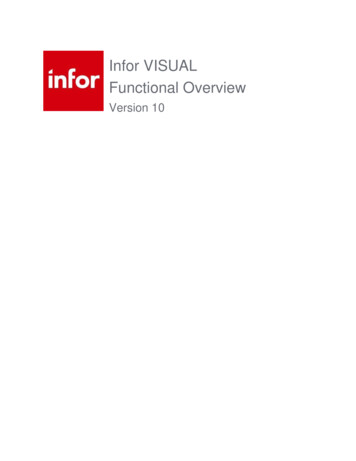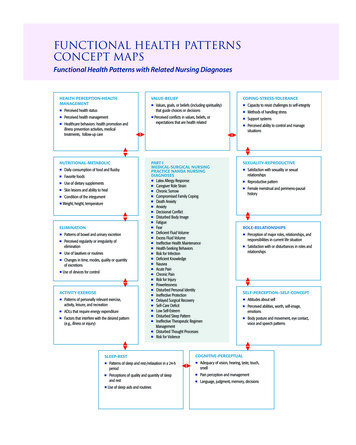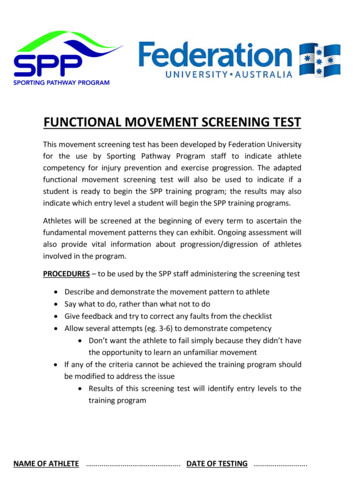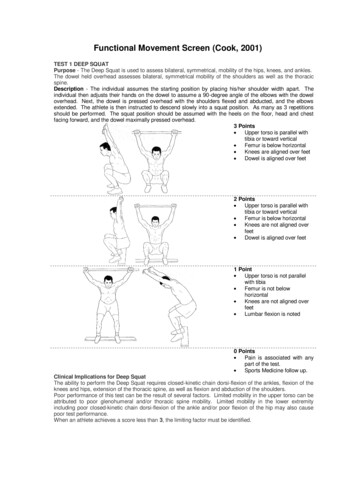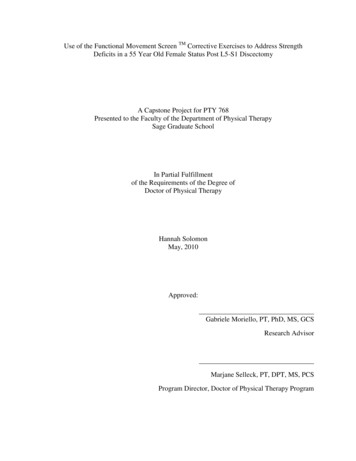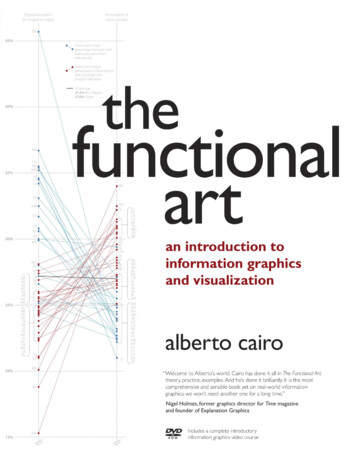
Transcription
Praise for The Functional Art“Welcome to Alberto’s world. Cairo has done it all in The Functional Art: Theory, Practice,Examples. And he’s done it brilliantly. It is the most comprehensive and sensible bookyet on real-world information graphics. We won’t need another one for a long time.”—Nigel Holmes“If graphic designer Nigel Holmes and data visualizer Edward Tufte had a child, hisname would be Alberto Cairo. In The Functional Art, accomplished graphics journalistCairo injects the chaotic world of infographics with a mature, thoughtful, and scientifically grounded perspective that it sorely needs. With extraordinary grace andclarity, Cairo seamlessly unites infographic form and function in a design philosophythat should endure for generations.”—Stephen Few, Author of Show Me the Numbers“This book is long overdue. Whether you’re just getting started visualizing informationor have been doing it all your life, whether your topic is business, science, politics,sports or even your personal finances, and whether you’re looking for a basic understanding of visualization or a detailed how-to reference, this is the book you werelooking for. Alberto Cairo, a professional journalist, information designer and artist,shows how to visualize anything in a simple, straightforward, and intelligent way.”— Karl Gude, former infographics director at Newsweek and graphics editor inresidence at the School of Journalism, Michigan State University“The Functional Art is brilliant, didactic, and entertaining. I own dozens of books onvisual information, but Cairo’s is already on the shortlist of five that I recommend toanybody that wishes to have a career in information graphics, along with those byEdward Tufte, Nigel Holmes, and Richard Saul Wurman. Cairo is one of those rareprofessionals who have been able to combine real-world experience with the academia.”—Mario Tascón, director of the Spanish consulting firm Prodigioso Volcán“Using his enormous professional and academic experience, Alberto Cairo offers afirst-hand look at the revolution in visual communication. This book is key to understanding the current situation of print and online information design.”—Javier Zarracina, graphics director at The Boston Globe“The Functional Art is the perfect starting point for a career in information graphics andvisualization, and also an excellent guide for those who already have some experiencein the area. This is the first real textbook on infographics.”— Chiqui Esteban, director of new media narratives at lainformacion.com, andblogger at InfographicsNews
This page intentionally left blank
Population with aBA degree or higherPercentage ofobese peopleDC45%States with a largerpercentage of people withhigher education thanwith obesityStates with a largerpercentage of obese peoplethan of people witha higher educationtheUS average27.2% BA or higher27.0% RIWANMWYNHMNAKAZCANYNJVTMAMTHICTUTNVDCan introduction toinformation graphicsand visualizationalberto cairo
The Functional ArtAn introduction to information graphics and visualizationAlberto CairoNew Riders1249 Eighth StreetBerkeley, CA 94710510/524-2178510/524-2221 (fax)Find us on the Web at: www.newriders.comTo report errors, please send a note to errata@peachpit.comNew Riders is an imprint of Peachpit, a division of Pearson Education.Copyright 2013 by Alberto CairoAcquisitions Editor: Nikki Echler McDonaldProduction Editor: Tracey CroomDevelopment Editor: Cathy LaneProofer: Liz WelchComposition: Kim Scott, Bumpy DesignIndexer: FireCrystal CommunicationsInterior Designer: Mimi HeftCover Designer: Mimi Heft, with Alberto CairoMedia Producer: Eric GeoffroyVideo Producers: Amy Van Vechten, Andrew WallaceNotice of RightsAll rights reserved. No part of this book may be reproduced or transmitted in any form by anymeans, electronic, mechanical, photocopying, recording, or otherwise, without the prior writtenpermission of the publisher. For information on getting permission for reprints and excerpts, contact permissions@peachpit.com.Notice of LiabilityThe information in this book is distributed on an “As Is” basis without warranty. While every precaution has been taken in the preparation of the book, neither the author nor Peachpit shall have anyliability to any person or entity with respect to any loss or damage caused or alleged to be causeddirectly or indirectly by the instructions contained in this book or by the computer software andhardware products described in it.TrademarksMany of the designations used by manufacturers and sellers to distinguish their products are claimedas trademarks. Where those designations appear in this book, and Peachpit was aware of a trademarkclaim, the designations appear as requested by the owner of the trademark. All other product namesand services identified throughout this book are used in editorial fashion only and for the benefit ofsuch companies with no intention of infringement of the trademark. No such use, or the use of anytrade name, is intended to convey endorsement or other affiliation with this book.ISBN 13: 978-0-321-83473-7ISBN 10:0-321-83473-9987654321Printed and bound in the United States of America
This book is for Alice, Elena, and Julio.And for Erica, of course.
AcknowledgementsExperience teaches you that the archetype of the self-made man is a myth withroots in humankind’s relish for delusion. Life’s meanderings are determinedby chance and luck, and the only thing we can do to funnel those factors is toready ourselves to identify and seize opportunities when they pass by. We arethe product of effort as much as we are shaped by the people who surround us.In this sense, I feel I am one of the luckiest individuals on Earth: I will start thisbook saying that curiosity is the most important trait any communicator shouldhave. Therefore, I have to thank those who have ignited my curiosity throughoutthe years and have helped me focus it.This book is, first, for my parents. When I was a kid, my dad prompted me to lovebooks and good stories, both fictional and real, and to develop an insatiable hungerfor new knowledge. Inadvertently, he also revealed to me how to summarize andconvey information with images and how to be precise, concise, clear, and fun (orso I hope) when teaching others. In addition to being a medical doctor, my fatheris also an artist. He used to lecture on anatomy at a local university in Spain, andone of his former students once told me that, many years after graduating, theonly classes he remembered from college were my father’s. He told me it wasbecause of the beautiful diagrams and cutaways Professor Cairo used to sketchout on the blackboard while he talked.From my mother, I treasure a most relevant lesson: Don’t give up pursuing anddefending what you have been able to prove to be true, no matter what.Thanks to my editors, Nikki McDonald and Cathy Lane, at Peachpit Press. Theybelieved in this project from the very first day, and they encouraged me to keepwriting in times of fatigue.To Luis G. Prado, my editor and publisher in Spain, Óscar Fernández, from El País,and Ferrán Giménez and Laia Blasco, two colleagues at the Universitat Oberta deCatalunya: Years ago, they prompted me to put what I knew about informationgraphics and visualization into writing, and they aided me in making sense of it.I wish to thank several students of mine. First, Patricia Borns, who read almostthe entirety of The Functional Art and gave me valuable advice on how to improveits style. This book is much more readable because of her. Eileen Mignoni andSophia Dengo read and edited very preliminary chapters, years ago. I also gotsuggestions from Lex Alexander, Mel Umbarger, and Lauren Flowers, and frommany other of my undergraduate and graduate students at the University ofNorth Carolina-Chapel Hill and at the University of Miami.
To Nigel Holmes, Stephen Few, and Karl Gude for their kind comments aboutthe content of The Functional Art: Coming from them, their words mean a lot tome. They were three of my main sources when I was learning how to visuallydisplay information. They are giants with broad shoulders; I’ve taken advantageof that. Thanks also to Chiqui Esteban and Javier Zarracina, Spanish infographicsmasterminds.Many of the examples in The Functional Art come from my two years as directorof infographics and multimedia at Época magazine, in São Paulo, Brazil. I wish tothank the wonderful people I had the honor to work with. First, the infographics department: Marco Vergotti, David Michelsohn, Rodrigo Cunha, RodrigoFortes, Gerson Mora, Luiz Salomão, Gerardo Rodríguez, Erik Scaranello, andPedro Schimidt. Also, Época’s art director, Marcos Marques, author of some ofthe most impressive covers I’ve ever seen in a news magazine. Thanks also toHelio Gurovitz and his deputy, David Cohen, two managers with a backgroundin computer science and engineering who understand what visualization anddata journalism are about.To my colleagues at the University of Miami and at UNC-Chapel Hill: Rich B eckman,Laura Ruel, Don Wittekind, Pat Davison, Charles Floyd, Kim Grinfeder, MichelleSeelig, and Jim Virga. Also, to the deans who, since 2005, have supported me in theteaching of graphics and visualization: Richard Cole, Tom Bowers, Jean Folkerts,and Gregory Shepherd.To the people who, every year, organize and participate in the Malofiej International Infographics Summit (www.malofiej20.com): Javier Errea, Álvaro Gil, JohnGrimwade, Geoff McGhee, Juan Velasco, and so many others.To Mario Tascón and Gumersindo Lafuente, makers of www.elmundo.es, where Iwas graphics director between 2000 and 2005. They both trusted a certain rookiemore than a decade ago.To all my colleagues at La Voz de Galicia, Diario 16, El Mundo, DPI Comunicación,and all the other newspapers and magazines I have worked for, both as a full-timeemployee and as a consultant. I wish to also thank all the organizations, companies, and friends who graciously gave me permission to use their infographicsand visualizations in this book.Finally, The Functional Art is, above all, for my wife and kids. In the past severalmonths, they had to endure long hours of silence and deep concentration on mypart. Patience has never failed them. Writing is the most solitary activity I know.I could not have survived without their support. I love you.
About the authorAlberto Cairo teaches information graphics and visualization at the Universityof Miami’s School of Communication and serves as an advisor for the Masterof Arts in Technology and Communication program at the University of NorthCarolina (UNC)-Chapel Hill.In 2000, Cairo led the creation of the Interactive Infographics Department atEl Mundo, the second largest printed and the largest digital daily newspaperin Spain. Between 2001 and 2005, Cairo’s team won more Malofiej and Societyfor News Design (SND) infographics international awards than any other newsorganization worldwide.Cairo was a professor at UNC-Chapel Hill between 2005 and 2009, and has beenan invited lecturer and keynote speaker at all of the most influential internationalconferences on visual journalism and design. He has taught in the U.S., Mexico,El Salvador, Costa Rica, Venezuela, Ecuador, Peru, Brazil, Chile, Argentina, Spain,Portugal, France, Switzerland, Ukraine, Singapore, and South Korea. He has alsobeen a consultant with many top news publications in those countries. Since 2006,he has been a lecturer at the Universitat Oberta de Catalunya, the first publicuniversity in Spain to offer online accredited degrees.
About the DVDThe video course in the DVD that accompanies The Functional Art expands onthe contents of this book. The course is similar to the materials I’ve used in thepast in my classes at UNC-Chapel Hill and at the University of Miami so, in caseyou are an instructor, they may be a good starting point to develop your ownpresentation slides. If you are a professional or a student, please be aware thatmany of the examples showcased in the video course are different than the onesincluded in the book.The DVD is divided into three video lessons: First, there is an introduction to basic visuali zation concepts, followed by a discussion on the principles of graphicdesign, and finally, a section on how to plan for infographics projects.In the first video lesson, I delve into the ideas outlined in the first section of TheFunctional Art. You will learn, for instance, why infographics should be “functionalas hammers, multilayered as onions, and beautiful as equations.” I also discusswhat strategies you can follow to choose the most appropriate graphic forms todisplay your information.In the second lesson, I explain the main principles of graphic design, such as unity,variety, and hierarchy, and how to apply them to create better layouts. I also giveyou some basic tips on how to better use type and color.In the third lesson, I discuss an impressive visualization made by the Britishnewspaper The Guardian. I also explain how I developed the chart on the frontcover of The Functional Art. You will see how I use Microsoft Excel and AdobeIllus trator, and why I call my approach “low-tech visualization.” This lesson isnot a tutorial on software tools, but it may give you a clue or two about how tostart a career in information graphics. If you work in this field already, this videomay reveal a few tricks that you can apply in your own projects.
ContentsIntroductionxivpart i foundations123Why Visualize: From Information to Wisdom5Rational OptimismLow-Tech Visualization to the RescueDrowning in Data? Only If You Don’t Know Howto SwimFrom Information to WisdomMaking Reality VisibleVisualization as a Technology6814151719Forms and Functions: Visualization as a Technology25An Information Graphic on
Praise for The Functional Art “Welcome to Alberto’s world. Cairo has done it all in The Functional Art: Theory, Practice, Examples. And he’s done it brilliantly. It is the most comprehensive and sensible book yet on real-world information graphics. We won’t need another one for a long time.” —Nigel Holmes “If graphic designer Nigel Holmes and data visualizer Edward Tufte had a .




